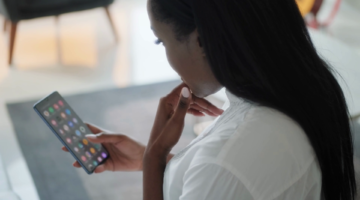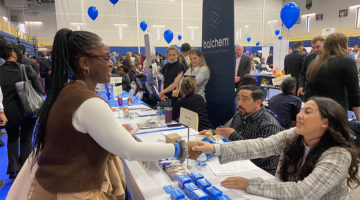By SAMANTHA MELAMED
The Philadelphia Inquirer
LANDENBERG, Pa. (AP) — A few years ago, Tiffany Beveridge was contemplating whether she wanted to have a third child. Instead, she gave birth to a Pinterest board.
Titled My Imaginary Well-Dressed Toddler Daughter, the page on the visual social-networking site was a place where the Landenberg resident and mother of two boys, ages 11 and 16, could simultaneously indulge her longing for gorgeous girls’ fashions and lampoon the culture the kiddy-couture images encapsulated. In the spirit of staying on trend, she named her imaginary daughter Quinoa.
“For about a year and a half, it was a simple little inside joke for me and my handful of friends that followed me on Pinterest,” she said. “And in June 2013, it literally went viral overnight.” After an influential mommy blogger, Jenny Lawson, tweeted about Quinoa, other bloggers covered her; she went from 100 followers to more than 10,000 in about 24 hours.
Now, Beveridge, 37, has close to 100,000 Pinterest followers, and a new book from Running Press, How to Quinoa: Life Lessons From My Imaginary Well-Dressed Daughter.
It’s remarkable, considering Beveridge started the board as a form of social daydreaming.
“I would see really cute little-girl clothes on my Pinterest feed but I didn’t feel that I had any claim to them. What was I going to do with them?” she said. “Then I realized Pinterest is all about your fantasy world, your fantasy kitchen, your fantasy vacation.”
But as she shopped for her imaginary daughter’s fantasy wardrobe, her sense of humor took over and she began adding captions — each one a micro-story that turns an absurd image into a character sketch about Quinoa, a miniature mean girl endowed with just the right blend of snobbery, cruelty, obliviousness, and fabulousness.
“When Quinoa wants volume, she doesn’t tease her hair, she relentlessly bullies it,” Beveridge captions an image of a girl who has been hairsprayed to within an inch of her life.
In another, showing an uninterested girl in a designer nightgown and headdress clutching a stuffed lamb: “Mary had a little lamb, but Quinoa has a better little lamb. And better hats. And more friends. Who’s calling the shots now, Mary?”
Beveridge thinks readers paid attention, in part, because she had turned Pinterest — where pin boards often tend to be more about style than substance — on its head. “It hadn’t really been done on Pinterest before, to use it as a satirical storytelling place.”
She’s not the first person to experiment with social media-based flash fiction. Twitter, in particular, has fostered such experiments, even organizing a virtual #twitterfiction festival annually for the last few years, and encouraging narrative innovation within its 140-character format.
But as a freelance copywriter who has written ads for Mrs. Field’s Cookies, Benjamin Moore, and DuPont, Beveridge has a special knack for selecting just the right pithy remark.
As her Pinterest board got the attention of bloggers and reporters, it also caught the eye of Allison Hunter, an agent with Inkwell Management in New York. In August 2013, the two met with some major publishers, and received a pre-emptive offer from Running Press, a member of Perseus Books Group.
But even after landing the book deal, the path from Pinterest board to book wasn’t a straight line.
Beveridge was confident she could bring the humor, but the photography was a different story. Stock images wouldn’t cut it, and orchestrating her own photo shoots would be impossibly expensive and time-consuming.
Instead, she ended up tracking down many of the photographers whose work she’d poked fun at on Pinterest, purchasing images and obtaining permission from each model and guardian to add the caustic captions. Almost everyone said yes, though one model had moved to Russia and proved impossible to contact.
In the book, Beveridge expands on the concept, calling on a cast of Quinoa’s slightly-less-fabulous friends, whose similarly on-trend names are drawn mostly from typefaces (Garamond), patterns (Chevron), and items stocked at Whole Foods (Edamame).
And, she offers Quinoa-flavored advice on how to be a hipster, maintain foodie credibility, coordinate acceptable playdate themes, or select an appropriate BFF. (Ask yourself: “Would your friend give you the shirt off her back, and more importantly, would you want that shirt?”)
Silly as she may be, Quinoa is meant to function as a lens through which to view popular culture.
The voice, Beveridge said, is drawn from “a conglomerate of books I’ve read and relationships between mothers and daughters that seem to be a little too enmeshed. I try to make the voice so that you don’t really know where Quinoa begins and the mother’s voice ends. It’s a blurry line.”
These days, she’s considering how to spread Quinoa’s wisdom to an even wider audience. She’ll be doing signings on Dec. 13, at Chester County Book Co. in West Chester. But that’s just the start.
“Tiffany’s voice is so clever and the Quinoa character is so funny and recognizable, that there’s really endless potential,” Hunter said. “We’ve talked about greeting cards, calendars, dolls. I know there’s been some talks with film and TV. It’s clearly striking a chord with people.”
Beveridge thinks Quinoa could be a children’s-book character in the vein of Eloise, a spoiled but entertaining kid who has lessons to learn.
“What I really wanted was a career where I could write books. In an odd way this imaginary child gave me that, and made this dream come true,” she said. “It’s kind of Hallmark, but that’s how it happened.”













No Comment